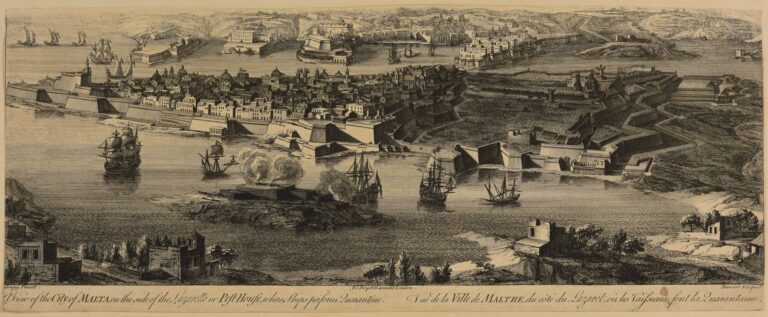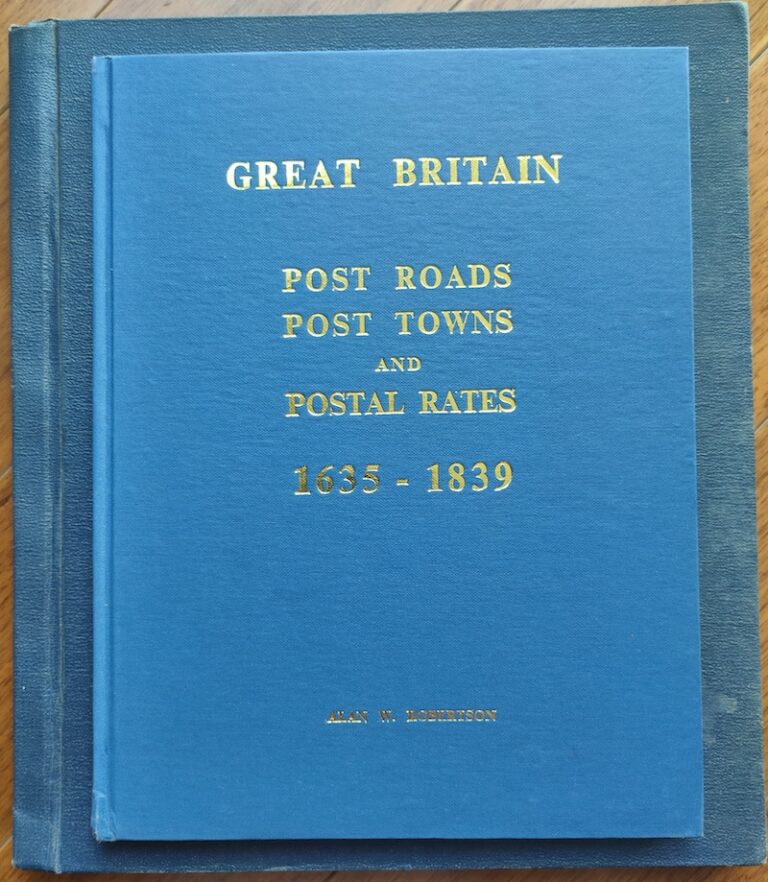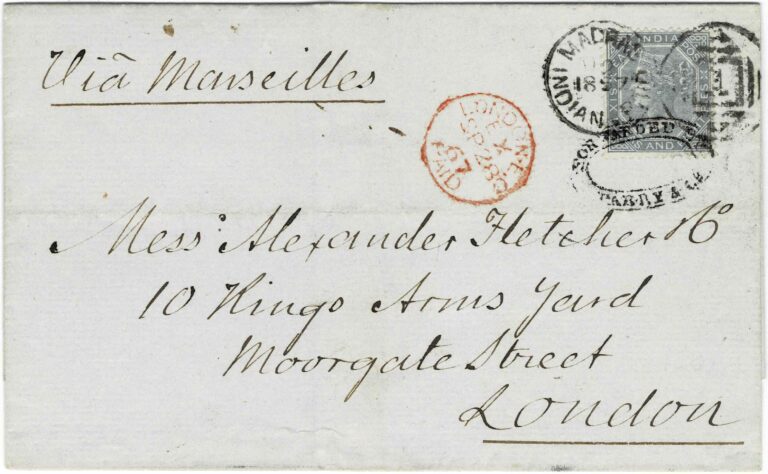A few days back, an item I purchase comes home (Figure 1). To be honest, at the time I bid on it, I don’t really pay as much attention to the affixed stamps as I should. The one thing that I am sure of, from a cursory glance at the image, is that the cover is a triple rate one (weighing between 1/2 and 3/4 of an oz) sent from India to France; I have been searching for one since I already possess covers paying the rates for single, double, and quadruple weights.


When I get the item, I total the value of the affixed stamps stamps and they sum to 19 annas 4 pies (19a4p). [Note 1]
And I think:
What the devil! The prevailing postage, as far as I am aware, was 19a6p for a triple letter; the single rate being was 6a6p per quarter ounce. Further this rate to France itself existed for a short period – I would kill to find the exact dates but I know it was effective for about 12-18 months starting sometime between 01.04.1873 and 31.03.1874 to sometime 01.04.1874 and 31.05.1875. So had the rates changed when this letter was sent i.e. on 15 April 1875?
A search of postal records doesn’t show me any rate change in this period. I start fearing that some stamps are missing from this cover. [Note 2] And I wonder:
If I divide 19a4p by three (triple weight remember), I don’t get any round number. So the rate must have been 19a6p when it was sent. But I can’t see any evidence of stamps having being removed at a later date. This cover comes from a well known correspondence and was sent from a small town in Southern India – Tellicherry. Did the local post office, deliberately or otherwise, allow the cover to pass underpaid?
I tell myself, over and over again:
This underpayment explanation is one that postal historians must be very wary of. It is an easy way out when one can’t explain things.

And I keep racking my brains until I remember something that I read long back. From the deep crevices of my mind, I retrieve a memory.
And I know I now have the right answer.
Nine Pies for Eight
The answer lies in a postal rule of that period which implied that 8p stamps were actually worth 9p. As far as the post office (PO) was concerned, the letter was properly franked 19a6p, exactly equal to the triple rate; even if, visually, the sum total of the stamps added up to 19a4p only.

To contrast, Figure 2 illustrates another triple weight cover [Note 2] from the same correspondence sent a couple of months earlier in February 1875. Unlike the earlier item, a visual examination of this one shows that the cover is franked exactly 19a6p.
Postal Documentation
So the cover in Figure 1 is not underpaid and neither is it missing any stamps, thankfully! It would be almost an insult to the postal administrations of that time if we start thinking that underpayments happened often; POs in most countries ran a tight ship then.
Now let’s look at some of the relevant postal documents.
On 27 March 1874, the Director General of the Post Office of India (DGPO) issued the following: [Note 4]
No. 7297
Memorandum
Office of the Director General
of the Post Office of India
Calcutta, 27 March 1874.
The sanction of Government has been obtained to the abolition of the six annas eight pie postage stamp label, [Note 5] to the abolition of the eight pie postage stamp label and to the substitution of a nine pie label: sanction has also been obtained to the consumption of the existing stocks of eight pie labels and their sale at nine pies each.
These measures will severally have effect from the I April 1874.
…….
A letter from the DGPO numbered 7298 to the Superintendents of Stamps, Calcutta, Madras, and Bombay, dated 20 March 1874 (note that the date is earlier than the letter numbered 7297 above) gives the reasoning for the 8p stamps to have an imputed value of 9p.
It may be explained that this is merely a temporary measure for the consumption of the present stock of this class of stamp, the Government having determined on the abolition of the eight pies label and the substitution of a nine pies label.
So, why did this 8p to 9p change take place? I don’t presently have access to postal documents and correspondence of the period and therefore I am not certain; nevertheless I will present two theories, one or both of which could have been responsible.
Theory #1: Silver and the Indian Rupee
One thought is that a decline in the value of silver and a resulting loss in the value of the rupee against sterling was the cause.
In 1835 that the Gold and Silver Coinage Act (no. XVII of that year) was passed in India. As per this act, the silver rupee of 180 grains troy, 11/12ths fine, was declared the sole legal tender throughout British India. This was, in fact, the coin that had been in circulation in parts of the country, such as Madras and Bombay. Further, the mints were opened to the public for free coinage of the metal. Thus, India was put on a mono-metallic silver standard.
Silver production got a great boost in the 1870s following the discovery of silver mines in the United States, Mexico, and elsewhere. In the decade of 1871-80, silver production increased to an average of 71 million ounces a year, a jump of 77% from the previous decade. The next two decades, 1881-90 and 1891-00, also saw large increases of 41% and 62% respectively (Figure 3). At the same time, the production of gold saw a fall.

This lead to a fall in the Gold-Silver Ratio, i.e. the number of ounces of gold that it takes to buy one ounce of gold. The major countries of the world including Great Britain were on the gold standard, and many in Europe were moving to it, while India was on the silver. This was disadvantageous to India – a steady decline in the value of the rupee against sterling ensued.
To quote some numbers, in 1871-72, 1r equaled 1s 11.125d (and not the theoretical 1r = 2s). Steady depreciation saw it fall to 1s 10.35d in 1873-74, 1s 8d in 1879-80, and 1s 2.625d by May 1893.
What does the weakening of the rupee have to do with the 8p / 9p issue? Well, the British PO had entered into contracts with various steamship companies to carry mails from/to/between countries, including India, and usually provided these companies with ‘subsidy’ for doing so. The Indian PO credited the entire sea postage it received on outgoing mails to its British counterpart. This amount of credit was fixed in sterling terms. If there was a decline in rupee i.e. if the sterling became stronger, the Indian PO would need more rupees to exchange for the same amount of sterling; [Note 6] effectively the post office’s outgo (or expenses) would increase.
It is quite possible that the steadily depreciating rupee was the reason for an increase in the foreign postage rates by 8p (approximately 1d) in May 1872. A Government Notification (Financial Department) No. 3584 dated 17 May 1872, is produced below:
Under the provisions of Section 21 of the Post Office Act of 1866, the Governor-General in Council is pleased to direct that the postage rates chargeable in India on letters addressed to foreign countries, the route to which lies through the United Kingdom (marked III in column 2 of the Foreign Postage Schedule of the Indian Postal Guide of May 1871) as well as to the Australian Colonies, Suez (by British Packet), Cairo (by British Packet), Alexandria (by British Packet), and Constantinople, shall be increased by 8 pie per half ounce (emphasis mine).
Sometime later, when 1d was deemed closer in value to 9p, the 8p stamp was itself abolished. The Indian PO had started preparations for the substitution of the 8p stamp with a 9p one in late 1872 itself; this is more than a year earlier to the date when the Government actually issued the required notification i.e. 27 February 1874. We know of a letter dated 4 September 1873 sent by the DGPO to the British security printers, De La Rue, requesting designs for the proposed 9p stamp refers to another letter dated 18 October 1872 on the subject.
Theory #2: Rounding Up
The rate increase by 8p in May 1872 can be understood through some examples. Figure 4 shows rates to certain destinations over three years. The initial five rows illustrate how the 8p increase affected rates to certain countries between 1871 and 1872.

The final four rows show how the substitution of the 8p stamp with the 9p one caused rates to some other countries to change.
So another explanation for the 8p to 9p change is that it made calculations and accounting easier. Earlier, some rates ended in 8p (2/3rds of an anna) and others in 4p (1/3rds of 1a). The new measure caused rates to end in either 9p (3/4ths of an anna) or 6p (1/2 anna).
References
- Bhatnagar, Bhagwat Sahai. A Comprehensive History of the Indian Post through the Ages. Vol. 7. 10 vols. New Delhi: Rima Publishing House, 2015.
- Dadachanji, B.E. History of Indian Currency and Exchange. 2nd ed. Bombay: D.B. Taraporevala Sons & Co., 1931
- Easton, John. The De La Rue History of British & Foreign Postage Stamps. London: Faber and Faber, 1958.
- Hausburg, L.L.R., C. Stewart-Wilson, and C.S.F. Crofton. The Postage and Telegraph Stamps of British India. London: Stanley Gibbons, Ltd., 1907.
- Martin, D.R., and Colonel Neil Blair. Overseas Letter Postage from India 1854-1876. London: Robson Lowe Ltd., 1975.
- Merrill, Charles White. Summarized Data of Silver Production. Washington: U.S Department of Commerce., 1930.
- Sinha, S.L.N. History of the Reserve Bank of India (1935-1951). Bombay: Reserve Bank of India., 1970.
Notes
[1] To elaborate on currencies: 12 pies (abbreviated ‘p’ hereinafter) = 1 anna (‘a’) and 16 annas = 1 rupee (‘r’). Further, 8p = 1 pence (abbreviated ‘d’) and 1r = 2 shillings (‘s’)
[2] From a monetary perspective, it would mean the cover is worth a fraction of what I have paid. Hence the fear.
[3] This cover isn’t with me but appeared on eBay. I bid on it but lost!
[4] The original of this memorandum is in the collection of the New Delhi based collector, Harsh Gupta.
[5] We won’t talk about the abolition of the 6a8p stamp in this post.
[6] Let’s understand this through an example. Suppose the Indian PO needs to send £1,000 to its British counterpart. At an exchange rate of 1r = 2s or 10r = £1, it would require 10,000 rupees. However, at an exchange rate of 1r = 1s11d or 10r = £0.9583, the PO would require 10,435 rupees.







